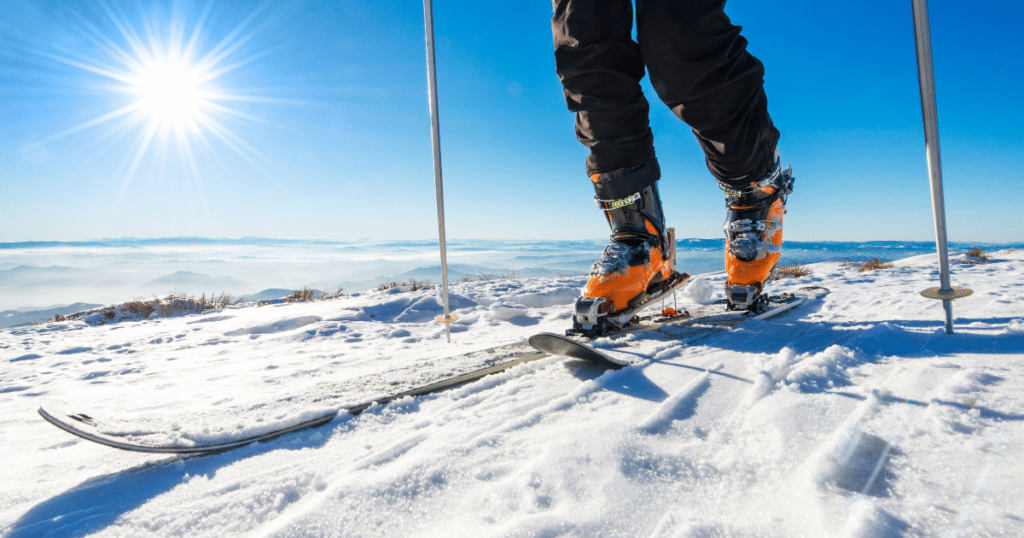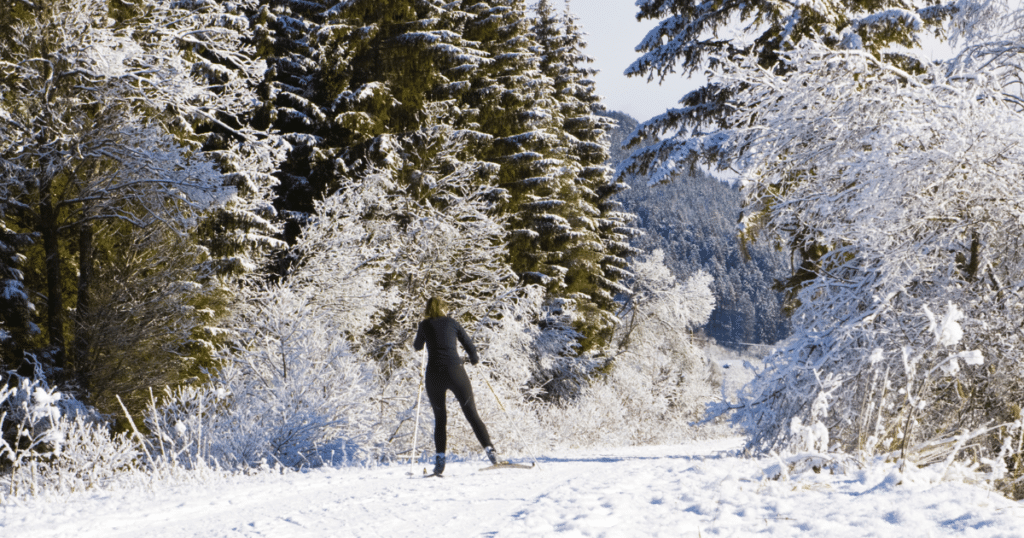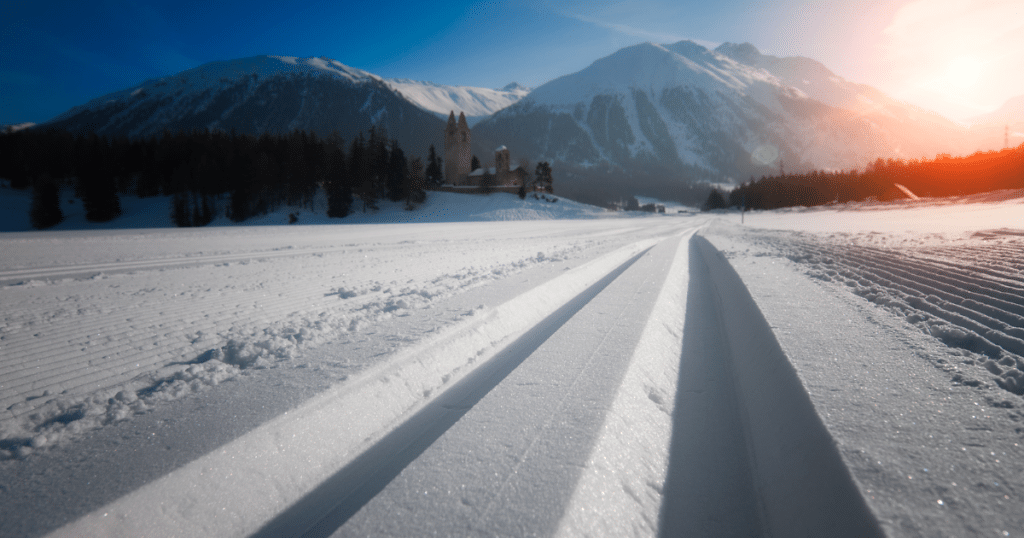RUNNING →
Level Up Your Nutrition Game With Our Freebies
Alex
I provide nutrition coaching for endurance athletes to improve performance and body composition through a simple and flexible eating style.
Hi, I'm
ATHLETE EATING GUIDE →
PROTEIN →
TRIATHLON →
RECIPES →
PERFORMANCE NUTRITION →
SUPPLEMENTS →
HOLIDAY & TRAVEL →
PLANT-BASED →
FEMALE ATHLETE NUTRITION
Explore the Blog
LEARN MORE →
ATHLETE GROCERY SHOPPING GUIDE →
RACE DAY: TRIATHLON NUTRITION PLANNER →
READY TO FUEL?
incredible value!
The fueling guide bundle serves as your one-stop-shop for strategies to fueling before, during and after your workouts.
ENDURANCE EATS
BINGE-WATCH READY!
YOUTUBE SERIES

Nonacceptance or embrace. Those seem to be the two very conflicting emotions when the weatherman announces the year’s first snowfall. While most running and cycling athletes I work with dread those snowy and icy winter miles, cross-country skiers welcome the powdery fluff. Whether you’re new to nordic skiing or a seasoned veteran, it’s important to be mindful of nutrition strategies to fuel that winter training. So let’s get into nordic ski nutrition and what you need to know!
Nordic skiing is such an incredibly demanding endurance sport with its own unique set of nutrition needs and challenges. Even the best intentioned athlete can fall short of training and race day goals due to lack of preparation. As the Minnesotans say, “Uffda! you betcha” want to make sure your nutrition is in check before hitting the snowy trails.
The Basics of Nordic Ski Nutrition
To best identify just how much to eat on a daily basis to support your nordic skiing adventures, it’s important to listen to your body’s natural hunger and fullness cues. Though as a point of reference, most skiers benefit from eating every 3-4 hours. And, by including all food groups to ensure calorie and nutrition needs are being met at baseline. Typically this equates to 3 meals and 2-3 snacks daily.
Protein
Research supports that adequate protein in endurance athletes speeds up muscle recovery and offsets muscle damage. Most endurance athletes, including nordic skiers, will benefit from 1.2-2.0 g of protein per kilogram of bodyweight. This should be spaced throughout the day at meal and snack times. Lean protein-rich food sources should be included on a regular basis. This could include: poultry, fish, beef, pork, eggs, dairy including Greek yogurt and cottage cheese, tofu, tempeh, seitan, edamame, beans and lentils, and protein bar or protein powder supplements.
Healthy Fats
Research shows that adequate dietary fat intake is important for giving your body enough fuel for training, helps with vitamin absorption, and decreases inflammation. About 20-30% of your diet should be composed of healthy fat sources including olive oil, nuts and seeds, olives, avocado, among others.
Carb Up: Foods to Fuel the Furnace
Carbohydrates are going to be the foundation of your meal planning and preparation routine. When you consume carbohydrates, your body breaks the food into glucose (sugar) and either uses it for activity (i.e. an upcoming ski) or converts into glycogen which is stored for later. Typically, most skiers require at least 55% of their calorie intake from carbohydrates. Though this can vary based on factors such as duration and intensity of the ski session. Other factors such as altitude also play a role. For nordic skiers, it is good to include both simple and complex carbohydrate sources in your routine.
Simple Carbohydrates:
Simple carbs are easy-to-digest. They are found in raw sugar, energy gels, energy or sports drinks, fruit and fruit juices, soda, candy, and foods with added sugars such as cookies and desserts. Foods that are high in simple carbohydrate content are low in dietary fiber and break down quickly to be used as energy. These foods are effective while training to provide quick bursts of energy. Experimenting with simple carbohydrates, including energy gels, while training is important to ensure that you will tolerate and minimize any risk of stomach cramps and upset.
Complex Carbohydrates:
Complex carbs take longer to digest and are found in higher fiber, nutrient-dense foods such as whole grains (barley, brown rice, quinoa,), legumes including beans and lentils, starchy vegetables such as sweet potatoes and pumpkin, among others. Baked oatmeal and pancakes are a couple of the ALN team favorites. These foods are excellent to include throughout the day in meals and snacks to boost your vitamin and mineral intake and help keep you feeling satisfied.
Athletes should consume >30-60g of carbohydrates per hour from carbohydrate-rich fluids or foods during a ski session lasting 1- 2 ½ hours. As the duration of the activity increases, so does the amount of carbohydrate needed for performance. For a ski lasting 2 ½-3 hours (or more), athletes should consume up to 90g of carbs per hour.

Benefits of Sports Products for Nordic Ski Nutrition
Sports nutrition products including sports drinks and energy gels are extremely portable and provide easy-to-digest concentrated nutrition that makes squeezing in carbohydrates and electrolytes a lot easier. Energy gels such as GU, Honey Stinger, Maurten, Spring Energy, among others provide simple carbohydrates to give you energy. Some skiers opt for chewable energy chews or gummies such as Jelly Belly sports beans, ProBar bolt chews or Skratch energy chews though if left out in the cold temperatures too long, these harden fast and can be difficult to chew.
Perhaps try a few of these options on easier ski days to find what works best for you both from a flavor and taste perspective and also a logistical perspective. Some of these options are easier to stash in pockets while other brands are larger and may be difficult to carry. It may be a good idea to also experiment with using a fuel belt to store your nutrition products.
Sports nutrition drinks such as Skratch, Tailwind or Nuun Endurance are also fantastic options. They make it easier to meet your fluid, carbohydrate and sodium needs. Reference our running race day fuel guide for more sports nutrition product options. Fortunately these products are great for any endurance athlete at any training level, including nordic skiers.
Easy, Portable Snacks to Pack for your Ski Adventures
Be sure to pack a few snacks (ideally that won’t freeze) when you are hitting the trails. These options are great for before, during or even after skiing. Consider adding in a sports nutrition beverage to optimize your nutrition further. If enjoying the snack post workout, combine with a good protein source such as yogurt, kefir, hard boiled eggs or a protein drink for optimal muscle recovery.
- Turkey and cheese bagel sandwich
- Cracker, pretzel, almond and dried fruit trail mix
- Breakfast bars such as Belvita
- Graham crackers with a banana
- Almond butter and jelly sandwich
- A few of our no-bake energy bites
- Blueberry muffin with dried banana chips
Nordic Ski Nutrition: Hydration Needs
Fluid requirements are higher in cold weather compared to more temperate environments. Cold air contains less water than warmer air, even if relative humidity is the same. Therefore cold exposure leads to a small but significant increase in respiratory water losses. Very little information exists on sodium losses when training in cold weather and hydration can be sometimes impractical and undesirable. Restricted access to fluids, having a frozen hydration bottle or fear of an unwanted pit stop to urinate pose challenges for skiers meeting hydration needs.
While individual fluid recommendations during exercise vary based on the individual, at minimum appropriate hydration is the goal. For most men, 16 cups (3.8L) and for women, 12 cups (2.9L) minimum daily is recommended. Though factors such as altitude can increase these needs even further than baseline.
During your ski session, consume 4-8oz of fluids every 15-20 minutes. In addition, aiming for at least 500 mg of sodium per hour while on the trails is ideal for electrolyte intake. An insulated bottle will be key to help prevent your fluids from freezing though adding additional salt to your sports beverage or water can also help. Start with lukewarm or room temperature fluids to further reduce the risk of freezing. Some skiers also have success with keeping a hand warmer in the bottom of their bottle holder and flip the bottle upside down to help avoid the mouthpiece from freezing.
Other Hydrating Beverages for Skiers
Certainly there are countless hydrating beverages other than plain water to help meet your fluid needs. Milk and milk alternatives, fruit juice, smoothies, protein drinks, broth and even hot cocoa all count towards your hitting your fluid goals.
Sports drinks can be heated before training and placed inside a bottle or thermos covered with an insulating layer. Experiment with beverages and flavors that appeal to you when heated. Warm sports drinks can be easier to consume on a cold winter day than cold drinks and these options can help to maintain your core body temperature.

Nordic Ski Nutrition: Fueling Race Day
For those skiers that are racing, repeat after me… “I will not try anything new on race day that I have not tried in training.” Aid stations on race day can be a desirable buffet. But, if you overdo it on foods that you have not trialed before, you may have unwanted consequences such as bloating or stomach upset. Research what foods and sports nutrition products are available at the aid stations on race day so that you can experiment with these products in training. The American Birkebeiner, a yearly prestigious ski festival, has 7 various aid stations across the course offering foods and beverages such as Nuun, GU energy gel, bananas, sandwich cookies, oranges, and stroopwaffles.
My team and I are here to support you if you are feeling that your everyday and ski nutrition need improvement. We are an experienced and passionate team that can get you fueling your best to support your performance nutrition goals. Check out my 1:1 performance nutrition coaching.
Alex
I provide nutrition coaching for endurance athletes to improve performance and body composition through a simple and flexible eating style.
Hi, I'm
LEARN MORE →
take the quiz!
Let's discover your Endurance Nutrition IQ
How well do you know your fueling? Answer these questions and let's see where your endurance nutrition knowledge is at!
Take the quiz
level up your nutrition game with these freebies
free downloadS
Protein-Packed 10-Day Sample Meal Plan
Athlete Eating Guide
Athlete Grocery Shopping Guide
1
2
3
Inspiration to fit 120 grams of protein into your day
Planning what goes on your plate
Putting the right foods in your grocery cart
